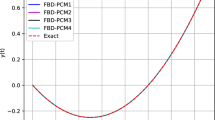Abstract
In this contribution, two general expressions for Markov parameters (MPs) and time moments (TMs) of continuous interval systems (CISs) are proposed. The TMs and MPs are derived in such a way that they do not require the inversion of the denominator of the transfer function of a given system. Additionally, there is no requirement for the solution of interval equations for obtaining TMs and MPs. The applicability of derived TMs and MPs is shown with the help of CIS model order reduction (MOR). The method utilized for the CIS MOR is the Routh–Padé approximation. The whole MOR procedure is explained with the help of one test case where the third-order system is reduced to first-order and second-order models. To establish the efficacy of the proposed method, the step and impulse responses of the system and model are plotted. For a fair comparative study, time-domain specifications such as the peak value, rise time, settling time, peak time and steady-state value for the lower and upper limits of the model are presented. Furthermore, the integral square error, integral absolute error, integral of time multiplied absolute error and integral of time multiplied square error for the difference between the responses of the system and model are tabulated. The results presented prove the applicability and effectiveness of the proposed method.







Similar content being viewed by others
Data Availability
My manuscript has no associated data.
Abbreviations
- \({G_n(s)}\) :
-
System transfer function
- B :
-
System numerator coefficients
- A :
-
System denominator coefficients
- T :
-
System time moments (TMs)
- M :
-
System Markov parameters (MPs)
- \({H_p(s)}\) :
-
Model transfer function
- \(b^*\) :
-
Model numerator coefficients
- \(a^*\) :
-
Model denominator coefficients
- \(t^*\) :
-
Model time moments (TMs)
- \(m^*\) :
-
Model Markov parameters (MPs)
- P(s):
-
Kharitonov polynomial coefficients
References
B. Bandyopadhyay, O. Ismail, R. Gorez, Routh–Pade approximation for interval systems. IEEE Trans. Autom. Control 39(12), 2454–2456 (1994)
B. Bandyopadhyay, V. Sreeram, P. Shingare, Stable \(\gamma \)–\(\delta \) Routh approximation of interval systems using Kharitonov polynomials. Int. J. Inf. Syst. Sci. 4(3), 348–361 (2008)
B. Bandyopadhyay, A. Upadhye, O. Ismail, /spl gamma/-/spl delta/Routh approximation for interval systems. IEEE Trans. Autom. Control 42(8), 1127–1130 (1997)
J.K. Bokam, N. Patnana, T. Varshney, V.P. Singh, Sine cosine algorithm assisted FOPID controller design for interval systems using reduced-order modeling ensuring stability. Algorithms 13(12), 317 (2020)
J.K. Bokam, S.N. Raw, V.P. Singh, An improved method for reduction of continuous interval systems using Anderson corollary. J. Stat. Manag. Syst. 23(2), 453–461 (2020)
F. Chinesta, P. Ladeveze, E. Cueto, A short review on model order reduction based on proper generalized decomposition. Arch. Comput. Methods Eng. 18(4), 395 (2011)
M. Chodavarapu, V. Singh, R. Devarapalli, Interval modeling of Riverol–Pilipovik water treatment plant and its model order reduction, in Computing Algorithms with Applications in Engineering. ed. by V.K. Giri, N.K. Verma, R.K. Patel, V.P. Singh (Springer, Singapore, 2020), pp. 361–367
A.K. Choudhary, S.K. Nagar, Model order reduction of discrete-time interval system based on Mikhailov stability criterion. Int. J. Dyn. Control 6(4), 1558–1566 (2018)
I. Dassios, G. Tzounas, F. Milano, The möbius transform effect in singular systems of differential equations. Appl. Math. Comput. 361, 338–353 (2019)
I. Dassios, G. Tzounas, F. Milano, Participation factors for singular systems of differential equations. Circuits Syst. Signal Process. 39(1), 83–110 (2020)
P. Dewangan, V. Singh, S. Sinha, Improved approximation for SISO and MIMO continuous interval systems ensuring stability. Circuits Syst. Signal Process. 39, 1–12 (2020)
K. Kumar Deveerasetty, S. Nagar, Model order reduction of interval systems using an arithmetic operation. Int. J. Syst. Sci. 51(5), 886–902 (2020)
A.P. Padhy, V. Singh, V.P. Singh, Model order reduction of discrete time uncertain system. J. Inf. Optim. Sci. 41(2), 661–668 (2020)
A.K. Prajapati, R. Prasad, J. Pal, Contribution of time moments and Markov parameters in reduced order modeling, in 2018 3rd International Conference for Convergence in Technology (I2CT) (IEEE, 2018), pp. 1–7
V. Singh, J. Bokam, S. Singh, Best-case, worst-case and mean integral-square-errors for reduction of continuous interval systems. Int. J. Adv. Intell. Paradig. 17(1–2), 17–28 (2020)
V. Singh, D.P.S. Chauhan, S.P. Singh, T. Prakash, On time moments and Markov parameters of continuous interval systems. J. Circuits Syst. Comput. 26(03), 1750038 (2017)
V.P. Singh, D. Chandra, Routh-approximation based model reduction using series expansion of interval systems, in 2010 International Conference on Power, Control and Embedded Systems (2010), pp. 1–4. https://doi.org/10.1109/ICPCES.2010.5698658
V.P. Singh, P. Chaubey, D. Chandra, Model order reduction of continuous time systems using pole clustering and Chebyshev polynomials, in 2012 Students Conference on Engineering and Systems (2012), pp. 1–4. https://doi.org/10.1109/SCES.2012.6199028
G. Tzounas, I. Dassios, F. Milano, Modal participation factors of algebraic variables. IEEE Trans. Power Syst. 35(1), 742–750 (2019)
Acknowledgements
This work is supported by the Science and Engineering Research Board (SERB), Department of Science and Technology (DST), Government of India (Grant No: ECR/2017/000212).
Author information
Authors and Affiliations
Corresponding author
Additional information
Publisher's Note
Springer Nature remains neutral with regard to jurisdictional claims in published maps and institutional affiliations.
Rights and permissions
About this article
Cite this article
Meena, V.P., Singh, V.P. & Barik, L. Kharitonov Polynomial-Based Order Reduction of Continuous Interval Systems. Circuits Syst Signal Process 41, 743–761 (2022). https://doi.org/10.1007/s00034-021-01824-4
Received:
Revised:
Accepted:
Published:
Issue Date:
DOI: https://doi.org/10.1007/s00034-021-01824-4




